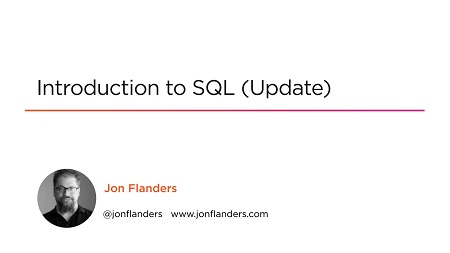
English | MP4 | AVC 1280×720 | AAC 44KHz 2ch | 3h 02m | 401 MB
The vast majority of applications that use data, are backed by a good relational database system. This course will help to establish a base to those who want to begin learning Structured Query Language (SQL).
Structured Query Language (SQL) is a special purpose language for interacting with relational databases. In this course, Introduction to SQL (Update), you will learn the basics of Structured Query Language. First, you will learn how to query data and shape results. Next, you will focus on creating and modifying data in your tables. Finally, you will touch on how actually modify the tables themselves. By the end of this course, you’ll understand the basics of how to create and use a relational database.
Table of Contents
01 – Course Overview
02 – Introduction
03 – The Relational Model
04 – Summary
05 – Introduction
06 – Basic SQL Commands – SELECT
07 – Basic SQL Commands – INSERT
08 – Basic SQL Commands – UPDATE
09 – Basic SQL Commands – DELETE
10 – Course Housekeeping
11 – Summary
12 – Introduction
13 – Demo – SELECT
14 – The SELECT List
15 – SELECT List Wildcard (_)
16 – The FROM Clause
17 – Demo – FROM Clause
18 – How to Constrain the Result Set
19 – DISTINCT and NOT DISTINCT
20 – Demo – Distinct
21 – Summary
22 – The WHERE Clause
23 – Demo – WHERE Clause
24 – Boolean Operators
25 – The AND Keyword
26 – Demo – AND
27 – The OR Keyword
28 – Demo – OR
29 – Other Boolean Operators
30 – BETWEEN
31 – Demo – BETWEEN
32 – LIKE
33 – Demo – LIKE
34 – IN
35 – Demo – IN
36 – IS
37 – IS NOT
38 – Demo – IS AND IS NOT
39 – Summary
40 – Introduction
41 – ORDER BY
42 – Demo – ORDER BY
43 – Set Functions
44 – Demo – Set Functions
45 – Set Function And Qualifiers
46 – Demo – Set Function And Qualifiers
47 – GROUP BY
48 – Demo – GROUP BY
49 – HAVING
50 – Demo – HAVING
51 – Summary
52 – Introduction
53 – CROSS JOIN
54 – Demo – CROSS JOIN
55 – INNER JOIN
56 – LEFT OUTER JOIN
57 – Demo – INNER JOIN
58 – OUTER JOINS
59 – Demo – LEFT OUTER JOIN
60 – RIGHT OUTER JOIN
61 – Demo – RIGHT OUTER JOIN
62 – FULL OUTER JOIN
63 – Demo – FULL OUTER JOIN
64 – SELF JOIN
65 – Summary
66 – Introduction
67 – INSERT
68 – Demo – INSERT
69 – BULK INSERT
70 – Demo – BULK INSERT
71 – UPDATE
72 – Demo – UPDATE
73 – DELETE
74 – Demo – DELETE
75 – Summary
76 – Introduction
77 – CREATE DATABASE
78 – Demo – CREATE DATABASE
79 – CREATE TABLE
80 – Demo – CREATE TABLE
81 – NULL Values
82 – PRIMARY KEY
83 – CONSTRAINT
84 – ALTER TABLE
85 – Demo – CREATE TABLE
86 – DROP TABLE
87 – Summary
Resolve the captcha to access the links!